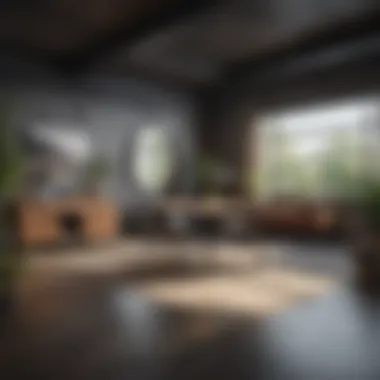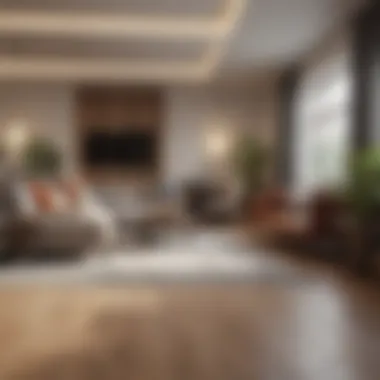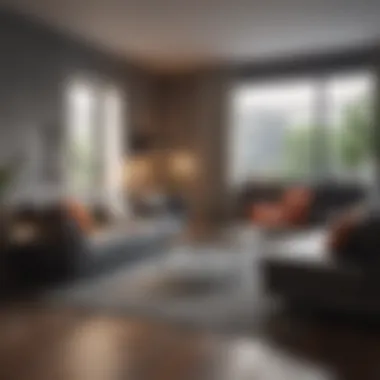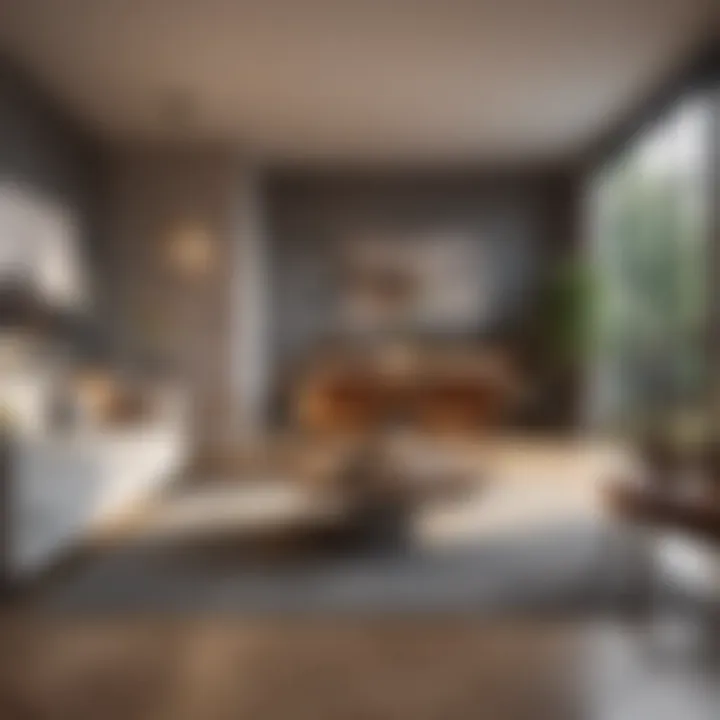Studio vs. Apartment: Key Differences and Insights


Intro
Understanding the differences between studios and apartments is crucial for anyone engaging with the real estate sector, be it buyers, renters, or investors. While both types of residences offer unique advantages, they also come with inherent drawbacks. This analysis focuses primarily on physical space, zoning regulations, financial implications, and the lifestyle choices associated with each category. Through meticulous examination, individuals can better navigate their options.
Inspiring Homes
Space Utilization and Layout
The floor plan of studios is usually defined by a single open space, combining living, sleeping, dining, and cooking areas into one cohesive environment. This compact design promotes efficient use of available space, making it particularly appealing for minimalists and those in urban areas where square footage comes at a premium. In contrast, an apartment typically features distinct rooms allocated for sleeping, cooking, and entertaining. The presence of separate spaces promotes privacy and the capability to host guests without encroaching on personal areas.
Key Considerations:
- Space Functionality: Studios maximize space but may not suit everyone.
- Privacy: Apartments offer more separation and comfort for families.
- Design Flexibility: Studios require thoughtful design solutions.
Target Audience
Primarily, studios appease singles, students, or young professionals who value affordability and location over spaciousness. Apartments, however, attract a broader demographic including families, couples, and older individuals seeking fuel space and convenience. Analyzing the target population for each dwelling highlights not only lifestyle preferences but also financial capacities that may affect decision-making.
Demographic Insights:
- Studios: Represent the rising trend of urban living, attracting young professionals.
- Apartments: Stand as strongholds for families needing more dedicated space.
Financial Considerations
When it comes to financial insights, studios often promise lower rent, thereby making them attractive options for first-time buyers or renters. Yet, potential buyers must consider upcoming renovation costs. Apartments may incur higher upfront costs given their often-bigger sizes and offerings, yet they also hold a greater potential for long-term equity appreciation. Understanding current market trends is essential for making judicious investments.
“Investing in real estate should be less about the charm of individual properties and more about the viability of influential trends.”
Lifestyle Implications
The choice between a studio and an apartment is significantly impacted by one's lifestyle preferences. Studios, being compact and often located in bustling urban centers, cultivate a vibrant community where residents often come together to socialize. On the other hand, apartments cater to individuals or families seeking quieter, more secluded living conditions along with the chance for recreational pursuits such as communal gardens or gym facilities.
Culmination of Section:
In sum, studios and apartments embody distinct lifestyles supported by differing space layouts, target demographics, financial implications, and intended usage patterns. Each option bridges the living circumstances, subsequently elucidating the capture of personal stories, aspirations, and living conditions.
Prolusion
The distinction between studios and apartments represents an evolving paradigm in urban living. As city landscapes change and housing demands transform, the choice between these two types of living arrangements becomes essential. This article aims to unravel the complexities surrounding this topic, offering insights into both forms of housing.
Understanding the characteristics of studios and apartments provides a pathway to discerning right choices for different lifestyles and financial situations. For many, the decision goes beyond mere preference. Space utilization, economic factors, and personal needs play a critical role in determining the ideal living situation.
Moreover, as urban areas face overpopulation, affordable housing options have become increasingly limited. Studios, often seen as budget-friendly solutions, appear attractive but may lack the comprehensive features that come with larger apartments. This dichotomy warrants analysis.
As we delve deeper into this subject, we will examine key differences—from layout contrasts to target audience analysis. This exploration not only caters to real estate enthusiasts or design aficionados, but resonates with anyone grappling with a move or a change in housing dynamics. By highlighting relevant factors, we benefit viewers by equipping them to make informed decisions based on their individual preferences and circumstances.
In this comprehensive analysis, clarity and depth will usher the reader through a better understanding of when to choose a studio over an apartment and why that choice matters.
Defining Studio and Apartment
Understanding the distinctions between a studio and an apartment is crucial in today's housing landscape. Each style offers unique characteristics that cater to different lifestyle needs and choices. Knowing these definitions aids individuals in making informed decisions when searching for living spaces. While both options serve as primary residences, they do so in fundamentally different ways regarding layout, design, and functionality. This section serves as the foundation for examining their specific qualities and nuancing the later discussions on layout differences, functional elements, and more.
What is a Studio?
A studio is a compact living space that typically combines the functions of a living room, bedroom, and kitchen into a single area. Often characterized by an open floor plan, studios are efficient use of space, targeting individuals or couples who prioritize location and affordability over square footage. In most cities, studios can be notably less expensive than one-bedroom apartments, which appeals to young professionals, college students, and minimalists seeking simpler lifestyles.
Studios can feature a small separate bathroom, but most do not offer any distinct separation between sleeping, dining, and recreational areas. Here are some defining characteristics of studios:
- Open floor plan: There are often no interior walls separating the living area from the sleeping area.
- Compact sizes: Studios usually range from 300 to 600 square feet.
- Multipurpose furniture: Often, residents use furniture that provides more than one function, like sofa beds or folding tables.
- Build quality: Many new studios cater to modern living with clever storage solutions and stylish, efficient designs.
These characteristics create a dynamic environment. This allows for flexibility and accessibility. Living in a studio often urges residents to develop innovative skills for space management and organization.
What is an Apartment?
An apartment, in contrast, is a self-contained housing unit that can vary in size and layout, typically consisting of multiple rooms, distinguishing one area from another. Apartments can be one-bedroom, two-bedroom, or even larger and are often found in multi-unit buildings. They are generally akin to more traditional living accommodations, providing residents separate areas for sleeping, eating, and living, which can accommodate families or roommates more comfortably.
Key aspects of apartments may include:
- Diverse layouts: Apartments range widely from one-bedroom designs to large multi-bedroom options, often with dedicated living and dining areas.
- Separate rooms: Typically includes kitchens that are distinct from living and sleeping areas.
- Various amenities: Apartments may have additional facilities that include pools, gyms, or communal spaces depending on the building’s offerings.
- Lengthy leases: Residents often engage in longer lease agreements, binding them to the unit for more extended periods compared to studio renters.
This structure supports a variety of demographics, including families, professionals, or shared living situations. Apartments can provide residents with space, which leads to greater privacy and comfort. Understanding the definitions of studio and apartment creates an essential framework for discovering more about layout variations and their respective target audience.
Layout Differences
Understanding layout differences is critical when comparing studio apartments with regular apartments. Layout shapes how residents live within their space, influencing key factors like comfort, functionality, and aesthetic appeal. A well-designed living area can enhance the quality of life and satisfaction of the inhabitants. Thus, it is vital to consider not just space, but how that space is arranged to accommodate daily activities and lifestyle needs.
Studio Layout Characteristics
Studios are often defined by their open-space concept, combining living, sleeping, and cooking areas into a single room. This layout offers several characteristics:
- Open Floor Plans: With no asserted walls separating the living, sleeping, and kitchen areas, morning light can flood in, creating an airy feel.
- Space Maximization: There typically is more innovation in organization. Furniture choices often include multifunctional elements such as sofa beds or foldable tables that conserve space.
- Flexibility: The lack of division between spaces allows inhabitants to dictate how they use their area daily. Whether working from home or entertaining, it is about customizing the space.


A potential downside is the feel of reduced privacy; any noise or movement in one area easily reaches others. Therefore, while studios maximize what is available, comfort found in somewhat branching separations is usually sacrificed.
Apartment Layout Variations
Apartments showcase a more segmented layout where designated rooms distinctly serve their purposes. Some relevant features involve:
- Separated Spaces: A common layout typically includes distinct areas like kitchens, bedrooms, and living rooms. This arrangement might appeal more to families or those seeking a traditional living style.
- Diverse Configurations: Apartments can range from one-bedroom studios to multi-bedroom flats. Design considerations reflect functionality from practical day-to-day usage to aesthetic preferences.
- Privacy and Noise Control: With rooms separated, residents difficultly hear one another in intimate or relaxing moments, encouraging a positive atmosphere.
Costs may influence these features. Though budgeting for distinct floorspace differs, the added privacy can make apartments more attractive despite potentially higher rent.
The layout aspects of living environments significantly impact life dynamics, shaping behavior, interactions, and overall well-being.
In summary, these differences in layout environments pose a solid foundation for potential renters to critique suitabilities for their lifestyles and preferences. Finding a harmonious balance between space utilization and comfort is essential for every individual. Whether opting for the modern open space of a studio or the clear rooms of a well-established apartment, understanding these layout differences can help make informed choices.
Functional Elements
Understanding the functional elements of living spaces is key when comparing studios and apartments. These elements affect the practicality and comfort of a residence. The layout and organization of space define how inhabitants can use it. Customized features, storage options, and efficiency contribute significantly to daily life.
Living Space in Studios
Studios are designed as open floor plans, where the living, dining, and sleeping areas are combined into one space. This cohesiveness can contribute to a sense of openness. Most of the time, demarcation occurs through furniture arrangements rather than walls. This fosters versatility. Residents can adjust the layout based on their needs or preferences.
A studio usually includes a kitchen nook or area. Depending on total space, some may need more creativity in furniture choices. For instance, a murphy bed can free up space when not in use. In addition, studios sometimes come equipped with minimalistic storage solutions. Tracking down a suitable shelving can be vital. While limited square footage presents challenges, many residents view such living as a chance for simplicity and minimalism.
Living Space in Apartments
Apartments generally offer distinct separations between rooms. You will often find designated areas for the kitchen, living room, and bedrooms. This division allows for privacy and varied activities to be performed concurrently. Families may prefer apartments as they tend to provide suitable environments for multiple occupants.
With more space, the potential for customization grows considerably. Apartments can also boast features such as spacious closets and appliances.
Some apartments might come equipped with amenities like balconies, larger kitchens, or communal facilities. These features cater to diverse lifestyles. As a result, they often appeal to different segments of the populace, from young professionals to families.
Overall, understanding living space dimensions is crucial. Both studios and apartments present unique qualities—a knowledge that aids prospective tenants in making informed decisions.
Target Audience Analysis
Understanding the target audience for both studios and apartments is critical in this analysis. The preferences and needs of individuals can greatly influence their decision-making process when choosing a living space. By delineating who typically chooses studios versus apartments, we can gain insights into lifestyle preferences, financial capability, and urban trends.
This audience analysis fosters a clearer comprehension of market dynamics and what individuals are looking for in the housing segment. These considerations emphasize factors such as:
- Lifestyle Choices: Each type of living space caters to different lifestyle choices and daily habits.
- Demographic Differences: Age, family size, and professional background are all factors in housing preferences.
- Affordability and Substance: Understanding cost implications reveals how one’s financial status influences the choice of residence.
- Life Stages: Whether seeking independence, starting a family, or downsizing can considerably shift the preferred living scenario.
This illuminating focus will assist readers in appreciating not just the physical structures but the human stories embedded within those lifestyles.
Who Typically Chooses Studios?
Studios attract a specific demographic characterized primarily by single individuals, young professionals, and students. These groups often prioritize affordability and location, seeking living arrangements that dovetail effectively with urban life. Compact living favors those with busy schedules who prefer seamless commutes and wanted amenities near their residences. Many tend to favor communal spaces or access to shared facilities, amplifying synergy among residents. They often possess fewer belongings, valuing flexible surroundings that adapt to a dynamic lifestyle.
The attraction of studios also lies in:
- Budget-Friendly Living: Monthly rent and utilities typically trend lower compared to larger apartments, making them appealing to a budget-conscious audience.
- Minimalist Mindset: Those who adopt a minimalist lifestyle choose studios as they facilitate decluttering and give inspiration to creatively maximize limited space.
- Urban Vibes: Frequently located near entertainment and work zones, studios also capture the interest of trendy urban dwellers interested in vibrant atmospheres.
Who Typically Chooses Apartments?
Apartments generally attract families and individuals desiring more space and privacy. Couples starting a family or professionals who prioritize work-from-home setups often find more comfort in apartments. Common reasons for selecting this style of accommodation generally include:
- Increased Space: More rooms equate to greater functionality for living arrangements, ideal for both small families and individuals needing dedicated offices.
- Enhanced Amenities: Larger complexes usually provide various amenities such as parks, gyms, or party rooms that enrich living experiences.
- Versatile Arrangements: The luxury of choosing from two or more bedrooms caters towards growing needs, be it for children, guests, or hobbyist exploration.
Consequently, those considering apartments often portray:
- Stability and Security: This demographic may lean toward long-term investments in their living situations.
- Community and Networking: Are often embedded within neighborhoods that foster relationships among residents thereby promoting a sense of community and safety.
- Accommodation Growth: Naturally evolves with lifestyle changes, regardless if one is venturing into cohabitation or simply needing more space to breathe and stretch out.
Financial Considerations
Understanding the financial dimensions of choosing between a studio and an apartment is crucial for potential renters and buyers. These choices carry different implications, affecting both immediate expenses and long-term investments. It becomes essential to evaluate various elements including rents, maintenance fees, utilities, and other hidden costs.
The insights provided here can guide you in making a more informed decision, whether you are a first-time renter or looking to upgrade. A clear comprehension of the financial landscape surrounding these living spaces can reveal patterns vital to housing decisions.
Cost Implications of Studios
Studios often have a reputation for being cost-effective housing options. Typically, they are less expensive than large apartments, which makes studios attractive to younger individuals or those on tighter budgets. The average rent of a studio varies greatly depending on location and amenities, but in many urban environments, this could mean several hundred dollars less per month compared to a one-bedroom apartment.
In addition to the lower monthly rent, residents of studios may find their utility bills to be lower as well. Since the space generally needs less heating and cooling, savings can occur here. Additionally, many studio residents make the strategic choice of furnishing their units with multi-functional furniture. This can save money in several ways by minimizing the need for additional items that would require more financial outlay. However,
- Smaller Spaces: While lower initial costs are appealing, think about overall comfort and living standards as well. Some might sacrifice on space, which can impact quality of life.
- Market Fluctuations: Natural shifts in real estate markets can affect studio rents, making them more or less favorable in the long-term.
Cost Implications of Apartments
Apartments typically present larger spaces and more amenities but they also come with elevated monthly costs. Renting a one-bedroom or larger apartment means higher rent, often accompanied by added expenses. However, the price difference can sometimes be justified depending on the features available. Some apartments offer in-house laundry, spacious kitchens, and recreational facilities like gyms or swimming pools, which may appeal strongly to some demographics.
It's essential to analyze costs thoroughly. City living can mean dealing with a higher cost of living, and utilities in an apartment may rise accordingly due
- Maintenance Fees: Additional fees for repairs and maintenance may also appear in apartments, differing significantly from studios that often compressed living style.
- Average Living Expenses: Rents for apartments may trend higher during peaks in demand, influencing your budgeting. Also, hidden charges, although not universally systematic, may catch renters off guard.


The choice between a studio and an apartment today does not just circle around how much money you’re willing to pay but also revolves around your broader lifestyle requirements. Understanding all financial implications remains paramount.
Lifestyle Choices
In understanding the decision between studios and apartments, the role of lifestyle choices cannot be overstated. The living environment is more than just a shelter; it shapes routines, social interactions, and overall well-being. Both studios and apartments come with their unique appeal, connecting with various lifestyles. Analyzing the specific elements that define these choices reveals the thoughtful consideration necessary when selecting a place to live.
Living in a Studio
Living in a studio offers a certain simplicity and efficiency. The layout combines various functions into a single cohesive space, promoting a minimalist lifestyle. For many, this appeals due to fewer distractions and the potential to maintain a more organized living space. Studios are usually smaller, making it easier to manage household chores and reducing time spent on maintenance. This type of living suits individuals who prioritize mobility or those who frequently travel.
Additionally, rent for studios tends to be lower than that of traditional apartments. This can be advantageous for young professionals or students who wish to minimize expenses while still enjoying the benefits of city life. Complementary to the physical benefits, studios encourage resourcefulness when it comes to furnishing and decoration, often resulting in a uniquely personal space that reflects the occupant's creativity.
However, it's crucial to consider that living in a studio can also mean less privacy. Residents may find it more challenging to separate their work from their home life, especially in a remote work environment. The lack of distinct rooms may lead to feeling cramped or overwhelmed if one is not accustomed to such an arrangement. Thus, understanding personal comfort levels is vital before committing to studio living.
Living in an Apartment
On the other hand, apartments often provide more distinct spaces. This structural diversity is appealing for professionals considering family life or those needing dedicated areas for work or leisure. Different rooms can be a selling point, allowing for clearer boundaries between personal space and daily tasks. Additionally, many apartments come equipped with facilities like communal lounges, gyms, or gardens that can enhance social interactions and provide a sense of community.
Apartments can accommodate different stages of life, from young couples to established families. Unlike studios, which heavily emphasize downsizing, apartments offer flexibility in living styles, including the option for larger space with more set areas. This is valuable for individuals valuing privacy and separation of day-to-day activities.
While the financial aspect of apartments may be less favorable due to higher rent costs, shared amenities and safety can justify this increase. Furthermore, in certain urban areas, apartments are more likely to invest in enhanced security systems, offering a sense of safety that many inhabitants deem important. Embracing apartment life often requires thorough consideration of neighborhood characteristics, amenities accessibility, and commuting routes. Regular lifestyle activities should align with the expectations of apartment living.
In summary, the decision between studios and apartments directly relates to one’s lifestyle choices. Both options offer distinct advantages and disadvantages that will affect living preferences and ultimately contribute to one’s daily experiences.
Design Trends
Design trends hold significant weight when discussing the type of living space, be it a studio or an apartment. They reflect not only aesthetic values but also the functionality, cultural influences, and lifestyle preferences of the inhabitants. Understanding these trends is essential for anyone considering their options in urban living.
Current design trends often aim to optimize space utilization in instances where square footage may be limited. Accessibility and sustainability have become paramount in selecting design elements that resonate with modern living. The individuality of personal taste versus demands of urban landscapes contributes to evolving norms in design. This section delves into the distinctive characteristics observed in studios compared to conventional apartments.
Popular Studio Design Trends
Minimalism is a predominant trend among studios, focusing on reducing clutter and maximizing the available space. The key attributes often seen include:
- Multi-functional Furniture: Pieces like sofa beds and foldable tables are commonplace. They serve multiple purposes without overcrowding.
- Open Layouts: By minimizing the division between living spaces, studios create a feeling of spaciousness. This demand is fulfilled through less permanent room divisions.
- Natural Light: Large windows and light-colored finishes are favored to create warmth and simplicity.
Additionally, natural materials and neutral color palettes are now widely employed to establish a sense of calm and harmony within these compact living areas. The challenge is balancing aesthetics and functionality while creating a personal connection to the space.
Popular Apartment Design Trends
In contrast, apartments typically embrace a more diverse range of themes. Successful apartment designs offer varying solutions tailored to larger group of occupants. Some of the key elements adopted are:
- Separate Living Areas: Apartments often highlight designated zones for kitchen, living, and sleeping areas to enhance the sense of privacy.
- Innovative Kitchen Designs: Modern appliances and open-concept kitchens facilitate social interactions while enhancing usability, making them both stylish as well as practical.
- Smart Home Features: Integrating technology, many apartments now include smart thermostats, lighting, and security systems.
One often sees contemporary touches—bold colors, artistic visuals, and unique textures—woven throughout apartment design that aim to reflect the vibrancy of urban living. It caters to families and multi-person households who benefit from spacial independence while still valuing a cohesive aesthetic throughout the home.
Keeping abreast of these trends is crucial for real estate enthusiasts and interior design aficionados, as they inform market demands and technological adaptations in urban living spaces.
Pros and Cons
Understanding the pros and cons of both studios and apartments is crucial for any prospective tenant or buyer. This section will delve into the advantages and disadvantages of each living option, allowing individuals to make informed choices based on their expected lifestyles, preferences, and financial situations. By examining characteristics unique to studios and apartments, one can discern what best fits their needs.
Advantages of Studios
Studios offer several compelling benefits that attract many individuals, especially those in urban settings. One clear advantage is affordability. Generally, studio rents are lower than those of comparable apartments, making it a viable option for students and young professionals.
The compact nature of studios leads to efficient space utilization. Residents can maintain a less cluttered living environment, potentially promoting a minimalist lifestyle. Additionally, the open-concept design allows for flexibility in organizing and decorating the space, enabling personalization despite limited square footage.
Accessibility is another point to highlight. Many studio buildings feature minimal corridors and direct access, enhancing convenience for residents. Couples or single occupants adoping this living style can create an intimate atmosphere that embodies comfort, even in a limited area.
Key Benefits:
- Lower rental costs.
- Optimized and flexible living space.
- Reduced maintenance and home management responsibilities.
- Opportunities for minimalist life choices.
Disadvantages of Studios
While studios have their attractions, they are not without drawbacks. One significant factor is limited privacy. With the lack of distinct rooms, guests may disrupt personal space or routines quite easily. This can be challenging for individuals who value alone time or need private areas for work or other commitments.
A limited layout can also create storage challenges. Finding room for clothing, furniture, and personal belongings may prompt residents to pursue under-bed or vertical storage solutions, sometimes highligting what they do not have on hand. Finding adequate practical storage can diminish the cozi-ness or comfort of living there.
Silencing noise from neighbors is another concern. The compact build of most studio apartments means thin walls could make privacy a critical issue again, as sounds tend to carry more easily in communal living situations. Insularity in a studio can lead to disturbances that would not be present in apartments, where walls filter outside sounds more effectively.
Main Drawbacks:
- Lack of privacy.
- Insufficient storage options.
- Potential noise disturbances.
Advantages of Apartments
Apartments come with various strengths that cater to diverse lifestyles. Opting for an apartment typically translates to increased space, thereby facilitating better segregation of ‘work’ and ‘home.’ For families or individuals frequently hosting gatherings, an apartment enables a shared social environment within a dedicated living space.
In addition, apartment dwellers often enjoy enhanced privacy while engaging with community activities. Establishing defined boundaries within rooms, such as distinct kitchens, living rooms, and bedrooms, fosters an improved quality of life. Regardless of the apartment size, this layout model allows individuals to tailor their atmosphere while granting an exchange for privacy.
There are conveniences offered by many apartment complexes, such as laundry facilities or gyms. Such amenities add layers of modern living comforts that studios might lack. This aligns well with the needs of dynamic urban residents wishing to lead a busy lifestyle.


Key Advantages:
- Increased living space promote comfort.
- More privacy by designated rooms.
- Potential for communal amenities undex convenience.
Disadvantages of Apartments
However, apartments also have significant downsides. One major drawback is the higher price point compared to studios. With extended space comes more expenses, whether via mortgage or rent. This can widely negate the appeal for newcomers who are just beginning their journey in independent living.
Maintenance can sometimes be cumbersome. Some apartment residents may miss out on timely action to repairs or security matters. Depending on management responsiveness, unsolved issues such as a leaky faucet may persist over time, diminishing overall satisfaction within some communities.
Moreover, apartments frequently involve more hassle regarding noise disturbances due to proximity to other residents. Walls can carry disturbing sounds, leading to discomfort over personal enjoyment in what should ideally be a sacred personal environment.
Main Drawbacks:
- Higher costs compared to studios.
- Challenges in routine maintenance and management Team.
- Interface with neighbors can impact comfort.
With this rounded view of the advantages and disadvantages amalgamated, you should have a clearer picture on how to proceed. Careful consideration of lifestyle expectations combined with financial planning generally make the final choice a balanced decision.
Sustainability Considerations
Sustainability is becoming increasingly salient in discussions around real estate and urban living. As individuals become more eco-conscious, the sustainability considerations of both studios and apartments play a critical role. Evaluating the environmental impact of living spaces can shed light on how design choices influence our carbon footprint. This article will explore the primary factors related to sustainability, the benefits of selecting eco-friendly options, and thoughtful considerations for potential residents.
Eco-Friendly Aspects of Studios
Studios are lauded for their compact nature, which can offer significant environmental advantages. Being smaller in size, studios often require fewer resources to construct, heat, and cool. Reduced energy consumption is a primary eco-friendly attribute, making them attractive to environmentally-minded individuals. The smaller living space means less lighting and lower energy costs. Additionally, studios often feature less in terms of building materials, cut down considerably on waste during construction.
Another notable eco-friendly aspect is the ability for efficient space organization and design. Many studios integrate elements like multi-functional furniture and open layouts, promoting a minimalist lifestyle. This fosters intentions towards sustainability by discouraging excess consumption. Integration of sustainable materials, such as bamboo or recycled metals, can further enhance the ecological benefits.
Living in a studio can also offer convenience to public transport and local amenities. This location choice can result in less reliance on vehicles, contributing to reduced greenhouse gas emissions. Furthermore, these advantages make studios perfect for environmentally conscious, urban dwellers.
Eco-Friendly Aspects of Apartments
Apartments, particularly those designed with sustainability in mind, can offer similar benefits, sometimes on a broader scale. Many new developments incorporate green building techniques, such as high-efficiency heating and cooling systems, recycled materials in construction, and eco-friendly insulation. These designs emphasize energy efficiency, leading to lower overall utility costs for tenants.
Moreover, modern apartment buildings frequently include common areas that promote community and shared resources. This can involve the sharing of transitory goods, such as laundry facilities or storage spaces that minimize waste. Moreover, developments that offer rooftop gardens or green walls contribute positively to the urban ecosystem, improving air quality and providing residents with natural spaces in what can be otherwise concrete environments.
Apartments can utilize effective waste management and recycling systems, playing a crucial role in urban sustainability. Formal structures to encourage recycling this provide additional layers of support to tenant's daily habits. Choosing an apartment equipped with such a system reduces landfill dependence and illustrates a commitment to environmental stewardship.
Future Trends in Urban Living
Urban living is right now in a period of transition. The growth of populations in cities drives change in many aspects of life, including housing, work, and recreation. Within the context of this article, the evolution of studios and apartments reflects broader societal shifts and lifestyle preferences. It’s crucial to explore these trends, as they can inform decision-making for prospective renters and buyers, as well as real estate developers.
One important element of future trends is the increased emphasis on compact living. The rise of remote work has reduced the need for larger living spaces, making studios more appealing for many individuals. Additionally, the focus on minimalism influences this choice of housing. People seek to reduce clutter and live simpler lives and studios suit that purpose by utilizing space more efficiently.
Another benefit involves the desire for community and shared resources. As urban centers grow, there is a noted preference for co-living spaces and designed personal areas within building complexes. Studies show that individuals living in close proximity often develop a sense of community, seen through shared workspaces or communal areas. These attributes make apartments attractive options for those valuing social connections in their metropolitan lifestyles.
We should also take into consideration the importance of sustainable living. Both studios and apartments, when built with eco-friendly materials and technologies, significantly impact urban environments. Increasing awareness of climate change allows opportunities for developers to integrate green building principles into designs. This grants potential tenants the chance to lead lifestyles more aligned with sustainable practices.
As urban living continues, understanding these elements will help individuals make informed choices in regards to the type of residence, be it a studio or a traditional apartment. It can help them grasp when one option may be advantageous compared to the other.
The Rise of the Studio Model
The studio model has gained momentum for numerous reasons connected to the dynamics of urban living. These trends often interlink with economic factors, leading to a shift in how individuals envision their living environments. Lower costs of studios compared to larger apartments make this option required for a significant number of urbanites, especially young professionals.
Flexibility and multipurpose functionality of space further enhance the popularity of studio apartments. Many contemporary residents prefer a more adaptable layout due to changing lifestyles. For instance, incorporating a home office within a small area becomes increasingly necessary given the rise of remote working. What once seemed restrictive now presents innovative opportunities for design.
This idea for flexible zones invites creativity. Developers work to create combinations of living, working, and entertaining spaces in studio formats, addressing evolving habits. Such transformations lead to ample renovations and sometimes total reconstructions in many cases.
Since studios provide efficiency in design and allow much focus on location over square footage, they entice singles or couples prioritizing access to city amenities. Being close to recreational venues often trumps spacious accommodations when choosing an urban residence.
The Evolution of Apartments
Apartments have transformed substantially as urban demands continually change. Traditional apartment layouts often consisted of rigid spaces, separating living areas from kitchens and resting quarters. However, contemporary architecture has introduced more fluid designs, reflecting the lifestyles of individuals today.
Open-concept layouts are prevalent in modern apartment designs. Such configurations allow inhabitants to experience larger visual spaces, enhancing the interplay of natural light across the interiors. This makes it suitable for entertaining guests and creating a sense of connectivity within living quarters.
Innovations in appliances and home technologies synchronize with modern apartment expectations. Interactivity increased as features such as smart thermostats and integrated kitchen systems emerge. These elements enhance convenience and reflect the productivity ingrained in daily routines now.
The combination of increasing real estate prices coupled with a high demand for unique lifestyles has led to multifamily residences hosting amenities previously exclusive to luxury apartments. Complexes now often include fitness centers, communal lounges, and outdoor terraces, allowing residents of various backgrounds a taste of a lavish lifestyle without the hefty price tag.
In essence, whether studios or apartments, understanding the evolution provides context to numerous elements affecting everyday urban living while also pointing to future considerations in housing choices.
The End
The conclusion is a significant section of this article, bringing together all the threads discussed in previous sections. It provides clarity and insight into the differences between studios and apartments, enhancing the readers understanding of their living options.
First, evaluating the functional elements in both studio and apartment designs has filled the gaps in practicality and lifestyle choices. The compact nature of studios strongly appeals to individuals valuing minimalism, while apartments cater to a broader spectrum of family-oriented structures.
Second, the financial considerations presented previously are critical for anyone contemplating a housing decision. The cost implications vary distinctly between these two layouts, and a comprehensive understanding can lead to informed financial choices. Choosing a studio might seem affordable, but ongoing expenses might add up, this makes clarity in expenses imperative.
Furthermore, sustainability remains a crucial topic navigating present and future living environments. As discussed in prior sections, both studios and apartments have unique ecological footprints. This conclusion reinforces that conscientious living caters to the global call for sustainability in urban settings.
Lastly, discerning the target audience plays an essential role in determining the right home. Understanding who typically chooses studios versus apartments can influence how future builds are approached in the real estate market. This knowledge allows potential renters or buyers to align their living spaces with their social circumstances and lifestyle preferences.
In sum, the conclusion serves not just as a summative recap but also as a crucial reflection of choice complexity. The deeper analytical perspective on studio versus apartment living invites real estate enthusiasts, travel lovers, and interior design aficionados to critically engage with this aspect of life. Addressing these considerations ensures that readers not only comprehend the nuances between studios and apartments but also makes astute decisions that reflect their unique needs and desires.
"Understanding the intrinsic qualities of various living spaces ultimately leads to better choices in urban living."
In essence, the dialogue around housing choices rests intricately on the layers of design, function, and individual ideals, emphasizing that personal context is monumental when choosing the right home.



